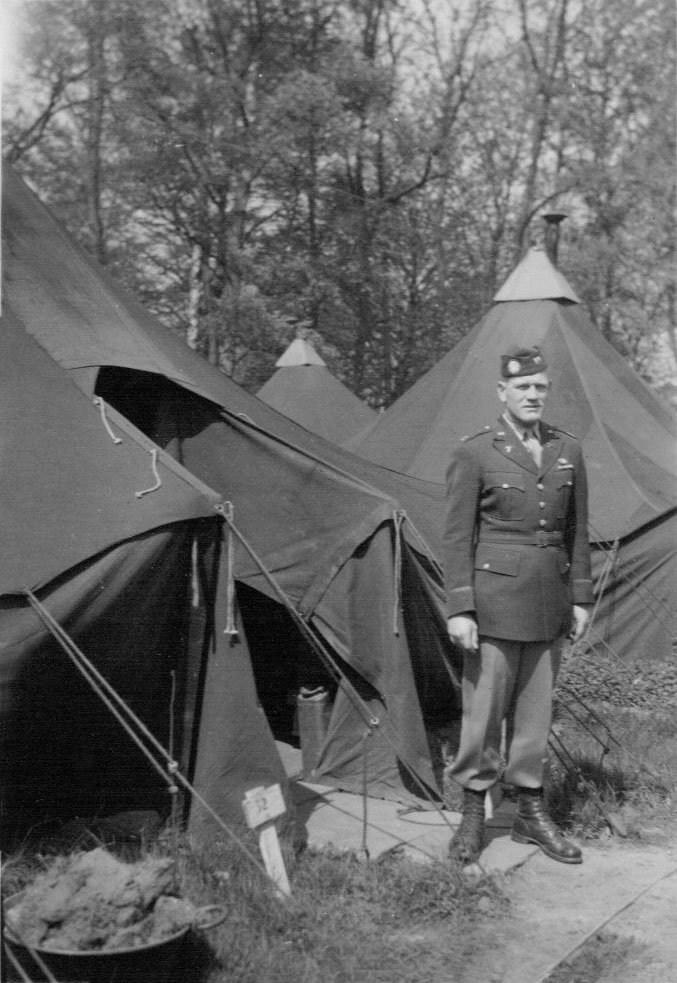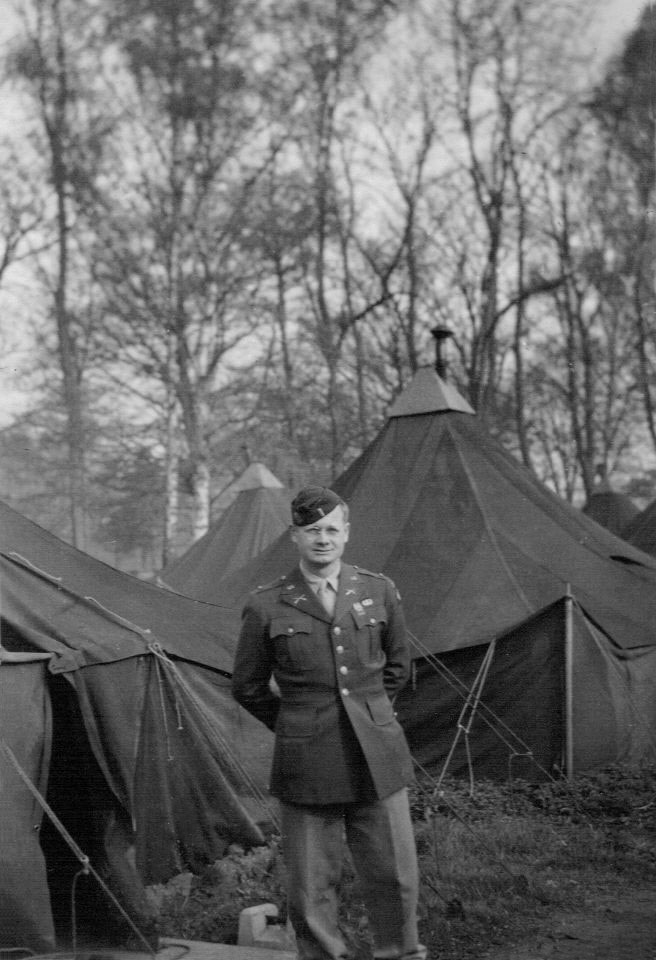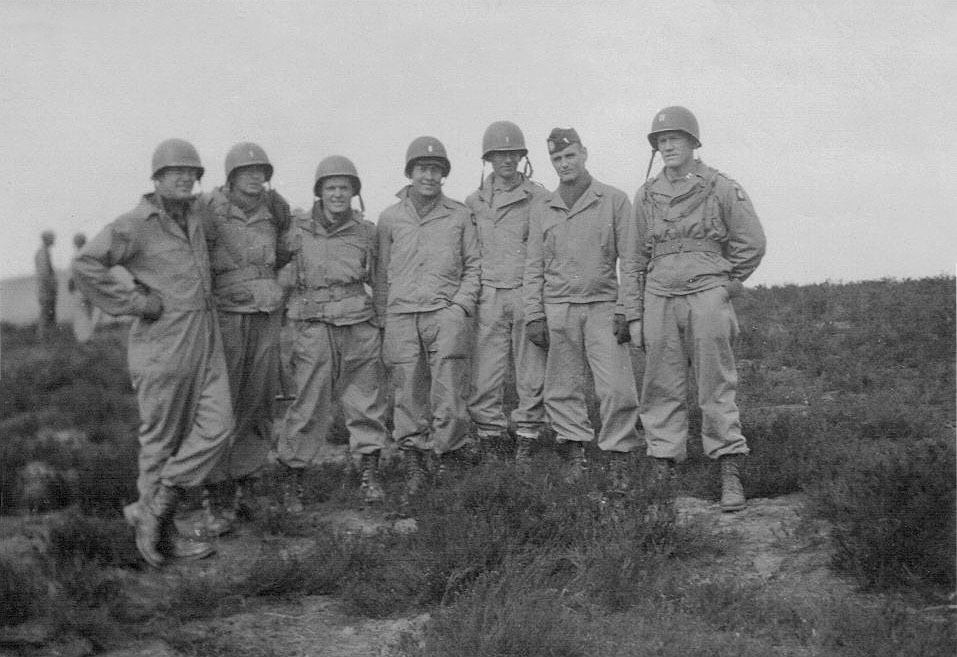
|
|
|
|
|
|
CONTACT US |
|

 |
|
||||||||||||
 |
|||||||||||||
|
|
2nd Lieutenant William J. Brunsman was born in Ripley County Indiana on June 18th, 1918. He
graduated from Connersville High School in 1935. Bill volunteered for Army service from his
hometown of Connersville, Indiana in 1941. He was inducted and sworn in at Indianapolis, Indiana and sent to Camp Shelby, Mississippi to begin his basic training on April 3rd 1941. In January 1942 he was assigned to the Panama Canal zone in Central America, sailing there on the John L. Clem, a 3,000 ton banana boat. On the next trip down, the boat was torpedoed and sunk by a German U boat. Bill was stationed there as a communications Sergeant on the Gatoon, Pedro Miguel, and Miraflores locks.
Home on leave, Bill was preparing to return to base when the Japanese attacked Pearl Harbor on December 7th 1941. He recalled his father telling him of the attack with tears in his eyes, it was the first time he had seen him cry. When his furlough was over, little did father and son know as they said their goodbyes it was for the last time. His dad would pass away while Bill served overseas for the next two years.
Selected for Army Officer Candidate School, he spent January through March of 1943 at Fort Benning, Georgia. It was while Bill was stationed here that he took notice of these elite men who seemed to be different and wore jump boots with their baggy pants. It was known that not just any one could make it into their group. Nine soldiers in Bill's circle of friends volunteered to become paratroopers, he was the only one to make it through the four week course and receive his jump wings. In later years Bill recalled paying particular attention in the sheds where parachute packing classes were held, as he had to pack his own chute for the first jump.
On April 20th 1943 the 505th Parachute Infantry Regiment along with the entire 82nd Airborne Division left Fort Bragg heading by train for Camp Edwards, Massachusetts, where they prepared for embarkation overseas. They were then moved by train to Staten Island, New York and the division, spread among three transport ships in a well protected convoy, sailed from New York harbor on April 29th 1943. The convoy contained the battleship Texas, an aircraft carrier, eight destroyers and twenty-three transports.** ** (Paratrooper; The Life of General James M. Gavin)
While on the ship crossing the Atlantic, Bill was awarded a U.S. Navy Expert Pistol Medal and Ribbon for pistol shooting. The 82nd arrived in Cassablanca, Africa on May 10th. He traveled through Rabat, Fez, and Oujda.He was issued an M1 Carbine as an Officer stateside but in Africa he traded in his carbine for an M1 Rifle which was a superior weapon. In late June 1943, General Ridgeway ordered the Division to it's staging area for the invasion of Sicily. The operation was named "Husky". On the 24th of June they left for Kairouan, Tunisia by all means of transportation, trucks, 40 & 8 boxcars and the real fortunate men flew by C - 47. It was here they departed for the Division’s first combat jump into Sicily on July 9th 1943. In Sicily Bill took out a tank with a bomb and received shrapnel in his back. His platoon medic dug the piece of metal out of his back while in the field. After operation Husky the 505 returned to North Africa in late August. On September 5th 1943 the 505 returned to Sicily to stage for a combat jump into Italy. There was a planned combat jump for a location outside of Rome. Men recalled being loaded onto planes but the drop was cancelled. Bill thought General Mark Clark felt German forces were to concentrated in and around Rome. There are accounts by some 505 troopers that their C-47's actually took off from Sicily and were airborne for the Rome drop but were shortly turned around and landed back on Sicily.
Bill made his 2nd combat jump onto the Salerno Beachhead along the Italian coast the night of September 15th 1943. The operation was called "Avalanche" and was in support of General Mark Clark’s 5th Army which was having trouble getting of the beach at Salerno with constant German shelling from mountains along the coast. The 505th was also to reinforce the 504th PIR (less their 3rd battalion) which had jumped in the night before. After the beachhead was secured Bill then went on into Naples. He was in Naples when the Post Office was blown up by retreating German units that left timing devices on explosives in the basement. The Germans may have also been responsible for the many deaths the 307th Airborne Engineers suffered when their living quarters also exploded. While the 2nd Battalion of the 505th proceeded to the Volturno river to seize several bridges the 3rd battalion remained in Naples to keep order.
When Avalanche ended for the 505 the regiment returned once again to North Africa and soon left by ship for Cookstown, Ireland on November 29th 1943. After a brief stay the 505 moved to Quorndon, Leicester, England better known as Camp Quorn. Here they prepared for the invasion of the continent. During training Bill volunteered for a low altitude experimental jump recalling when he jumped his chute made one oscillation to the right and then one to the left and hit the ground hard. Low altitude jumps got the men to the ground faster but increased their injuries.
Bill's third combat jump was into Normandy (Operation Neptune). On D-Day, June 6th 1944 in the early morning hours near the first town liberated, Ste. Mere Eglise, they were successful in their objective of taking the town and securing a road to keep the Germans from reinforcing their troops along Utah Beach. After D-Day, while fighting through the hedgerows, he was wounded in the upper left thigh by shrapnel from an artillery burst. When he got hit, he looked down at his leg and could see the big white bone, his first thought was, he had lost his leg. Bill recovered in time for the drop in Holland called operation "Market".
His 4th and last combat jump was Operation Market (Garden - was the British ground portion of the operation) at Groesbeek, Holland on September 17th 1944. This was the regiments first daylight jump. When Bill hit the ground in Holland his BAR man landed on top of him. While in Holland he had to shot a cow so his men could have fresh meat. General Jim Gavin came by and asked what was going on. Bill told him he had shot the cow for fresh meat for his men. Gavin then explained that they could not do this. Duke Boswell of G company tells of a similar story in "Four Stars of Valor". Once while returning from the field to Groesbeek Headquarters, G companies Captain Jack Isaacs, told him of how a mortar shell had come through the roof of the house they were staying in and landed on his bed. Fortunately, it did not explode. Before Bill was transferred to I company he had spent time with Jack Isaacs in G company. He remembered that Jack always had a smile and knew what he was doing as G companies commander.In December of 1944 the German's launched an attack along the thinly held American lines of the Ardennes Forest in Belgium. The German offensive became known as the Battle of the Bulge. The 505 was trucked to Werbomont, Belgium and from there they deployed along the Salm river. Bill said the snow was deep and they only had field jackets, no overcoats. They were not allowed to light fires and men were sick. He said “We lived like animals“. One day while moving through the forest something got up in front of him and he shot and killed a deer. During a German artillery barrage, an 88mm shell skipped by him but didn’t explode. When he got to the Siegfried Line, he could see the Dragons teeth, concrete blocks to keep tanks from getting by. He also saw the trenches from WW I which had not filled in yet. On 2-Feb-1945, after crossing the Siegfried Line and just over the German border at Losheimergraben, he and his Sergeant took out German pillboxes. As they approached the first pillbox he had a bullet go through the right sleeve of his field jacket and one went through his pant leg, he then was hit in the foot. With his lead scout they maneuvered to the rear of the pillbox where he climbed on top and threw Gammon Grenades down the chimney until all enemy surrendered. His Sergeant was killed during this action. The Platoon captured about 20 German prisoners. He was transported back to the hospital for surgery where they removed two bones and the bullet from his left foot which he kept. Bill received the Silver Star Medal for this action.
Bill made 4 combat jumps, fought in 5 campaigns, Sicily, Naples Foggia, Normandy, Ardennes, Rhineland. He was a recipient of the Silver Star, Purple Heart with Oak Leaf Cluster and Presidential Unit Citation with Oak Leaf Cluster. 4 Jump Stars and 1 Bronze Arrowhead on his European Theater Ribbon.
After surviving all this he had more than enough points and put in to come home. When Bill's paperwork came across the desk of Colonel William E. Ekman, the 505th Parachute Infantry Regiment Commander, he offered him a Captaincy with the Regiment to stay in uniform, but Bill said “I thought my luck had run out“. He was discharged as a 1st Lieutenant.
( We would like to thank Bill Brunsman's son's Greg and Gary for making this dedication possible)
For gallantry in action on 2 February 1945 near Losheimergraben, Germany. 2nd Lt. Brunsman Platoon Leader, skillfully and successfully captured 2 pillboxes and neutralized a third with a minimum of losses to his unit. After receiving a fragmentary field order, he quickly orientated his platoon and moved them across open ground by employing marching fire. When he neared the first objective, 2nd Lt. Brunsman quickly placed his automatic weapons to cover the ports and with his lead scout maneuvered to the rear of the pillbox where he mounted the pillbox and threw Gammon Grenades down the chimney until all enemy surrendered. Although wounded through the foot in this action, 2nd Lt. Brunsman continued to direct his platoon through its second and final objective. This act of courage and skill by 2nd Lt. Brunsman was in keeping with the traditions of the Airborne Forces.

Lt. William Brunsman (right) in Rabat Africa 1943.
Recognize the unknown trooper on the left side of the photo above email us here.
Captain Harold H. Swingler of I company, Camp Quorn, England 1944.
He was killed in action D-Day, June 6th 1944 leading his men in
an
attack against a German position.

Captain Robert Kirkwood, 3rd Battalion Headquarters Company, Camp Quorn
England 1944.

Back row standing left to right,
Lt. Joseph D. Meath, Lt. Walter B. Kroener, Capt. Harold H. Swingler, Lt. Joseph W. Vandervegt
Front row kneeling left to right,
Lt. Irwin, Lt. James W. Howell, Lt. William J. Brunsman, Lt. George E. Clark Jr.

Lt. William J. Brunsman is 3rd from left. The photo had "Holland" written on it's backside.

Recognize any of the unknown troopers in the photo above email us here.

|
|